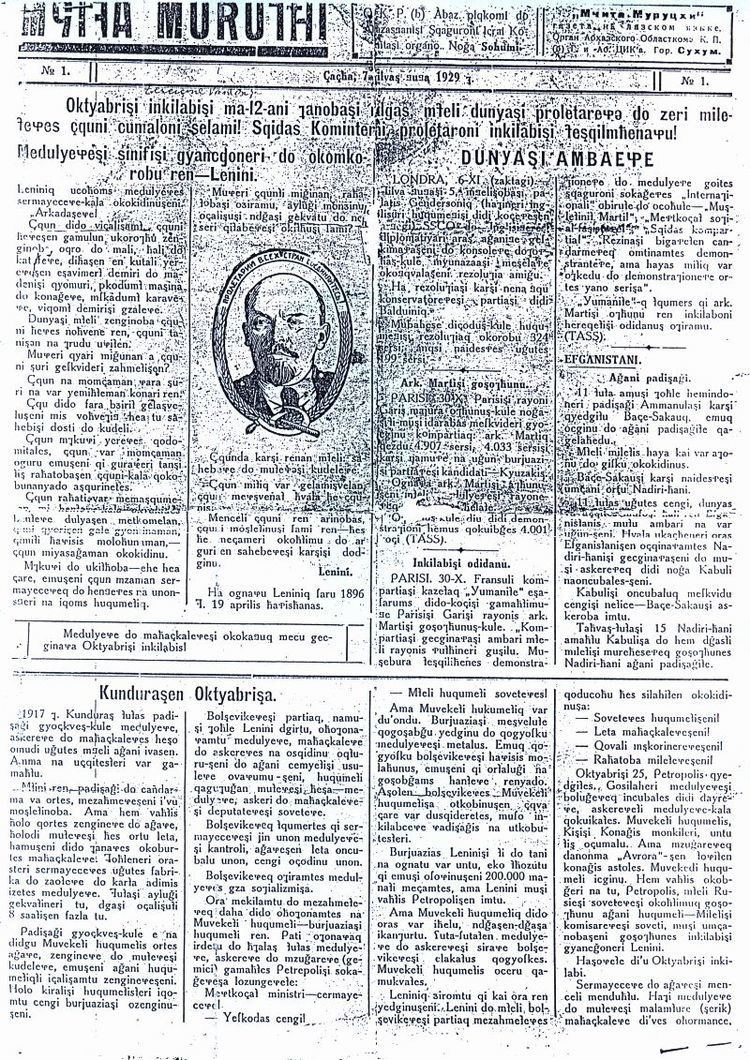 | ||
Laz is a Kartvelian language. It is sometimes considered as a southern dialect of Zan languages, the northern dialect being the Mingrelian language.
Contents
- Vowels
- Consonants
- Uvular q sound change
- Regressive assimilation
- Dissimilative deletion of consonant
- Intervocalic reduction of r
- Palatalization of velars
- Alphabet
- Grammatical cases
- Nouns
- Numerals
- Cardinal numbers
- Ordinal numbers
- Fractional numbers
- Verbs
- Person and Number
- Object markers
- Version
- Tenses
- Paradigm of verb conjugation
- Indicative
- Interrogative
- Imperative
- Subjunctive
- Conditional
- References
Today, the area where Laz is spoken stretches from the village Sarpi of Khelvachauri district in Georgia to the village Kemer of Rize province in Turkey. Laz is spoken also in Western Turkey in the villages created by Laz muhajirs in 1877-1878. In Georgia, out of Sarpi, the Laz language islets were also in Abkhazia, but the fate of them is obscure at present.
Laz is divided into three dialects: Khopa-Chkhala, Vitze-Arkabe and Atina-Artasheni. Dialectical classification is mainly conditioned by phonetic characteristics. More specifically, the crucial point is the reflexes of the Kartvelian phoneme [qʼ], which is maintained only in the Khopa-Chkhala dialect but has different reflections in Vitze-Arkabe and Atina-Artasheni dialects (see below).
Vowels
Laz vowel inventory consists of five sounds: a, e, i, o, u.
Consonants
Consonant composition of Laz varies dialectically. Full set of sounds is present in Khopa-Chkhala dialect, while Vitze-Arkabe and Atina-Artasheni dialects lost glottalized uvular q.
Uvular q sound change
Glottalized uvular q is preserved only in Khopa-Chkhala dialect before the vowels and the consonants v and l. This sound is also evidenced after glottalized stops and affricates in several words, such as p̌qorop (I love smb./sth.); ǩqorop (I love you); ťqubi (twins), ǯqv-/ǯqvin- (to reconcile); ç̌qinťi (fresh-soft and unripe). But in the most of cases *ťq → ťǩ; *ǯq → ǯǩ; *ç̌q → ç̌ǩ.
In the Vitze-Arkabe dialect, in the neighborhood of consonants *q → ǩ (exception is the verb ovapu ← *oqvapu "to be"). In the word-initial prevocalic and in the intervocalic positions *q → ∅.
In Atina-Artasheni dialect:
Regressive assimilation
The most common types are:
Dissimilative deletion of consonant
In some morphological contexts featuring two consonants n split only with a vowel, the former can be deleted. miqonun → miqoun (I have {an animate object}), iqvasinon → iqvasion (s/he will be), mulunan → *muluan → mulvan (they are coming).
Another dissimilation, presumably sporadic, occurs in deǩiǩe → deiǩe (minute); note also that the Arabic source of this word دقيقة daqīqa contains a uvular [q], and as above uvulars are unstable in Laz.
Intervocalic reduction of r
This process is evidenced in Khopa-Chkhala and Vitze-Arkabe dialects, where in intervocalic position facultatively r → y → ∅.
Palatalization of velars
In the Atina-Artasheni dialect, the velars followed by the front vowels e and i and the glide y transform to alveolar affricates:
Alphabet
Laz is written in a Georgian script or in the Latin script (as used in Turkish, but with specific Laz extensions).
Grammatical cases
Laz has eight grammatical cases: nominative, ergative, dative, genitive, lative, ablative and almost extinct adverbial.
Nouns
As in other sister languages Laz distinguishes two classes of nouns and classifies objects as:
Numerals
The Laz numerals are near identical to Megrelian with minor phonetic differences. The number system is Vigesimal like in Georgian.
Cardinal numbers
Almost all basic Laz cardinal numbers stem from Proto-Kartvelian language, except ar(t) (one) and eči (twenty), which are reconstructed only for Karto-Zan chronological level having regular phonetical reflexes in Zan (Megrelo-Laz) and Georgian. The numeral šilya (thousand) is a Pontic Greek loanword and is more commonly used than original Laz vitoši.
Ordinal numbers
Ordinal numbers in Laz are produced with the circumfix ma-...-a, which, in contrast with Megrelian, may be extended with suffix -n. The circumfix ma-...-a originates from Proto-Kartvelian and has regular phonetical equivalents in Georgian (me-...-e) and Svan (me-...-e)
Fractional numbers
The fractional numbers' derivation rule in Laz and Megrelian is akin to Old Georgian and Svan.
Verbs
Laz verb has the person, number, version, tense, mood, aspect and voice categories.
Person and Number
In Laz, like Megrelian, Georgian and Svan the verbs can be unipersonal, bipersonal and tripersonal
The person may be singular or plural.
Subject and object markers in Laz are the same as in Megrelian
Object markers
In pre-consonant position the markers v- and g- change phonetically:
Version
Like Megrelian, Georgian and Svan in Laz there are the four types of version marking:
Tenses
The maximum number of screeves in Laz is 22. They are grouped in three series. Two screeves (future I and past of future I) exist only for the verb r-, which serves as a 1st series root for oqopumu/ovapu/oyapu (to be).
Paradigm of verb conjugation
stems: ç̌ar- (to write) and r- (to be: just for future I and past of future I)
According to oldness these screeves can be grouped in two sets:
Classification of screeves according to oldness
Indicative
Indicative statement claims that the proposition should be taken as an apparent fact.
Interrogative
There are two ways to transform an indicative statement into a question:
Imperative
Indicates a command or request. The aorist form is used when addressing 2nd person (singular/plural) and aoristic optative in all other cases.
Subjunctive
Expresses possibility, wish, desire.
Conditional
Indicates condition in contrary to a fact. For this reason a verbal suffix -ǩo (At.-Arsh, Vtz.-Ark.) / -ǩon/-ǩoni (Khop.-Chkh.) is used.
